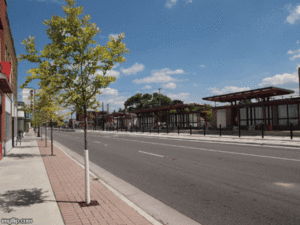
Difference between revisions of "Trees"
m |
m |
||
| Line 72: | Line 72: | ||
[[Category:Trees]] | [[Category:Trees]] | ||
[[Category:BMP]] | [[Category:BMP]] | ||
| + | [[Category:Level 1 - Best Management practices]] | ||
</noinclude> | </noinclude> | ||
Revision as of 16:39, 30 June 2022

Use of trees to manage stormwater runoff encompasses several practices. Tree trenches and tree boxes (collectively called tree BMPs), the most commonly implemented tree BMPs, can be incorporated anywhere in the stormwater treatment train but are most often located in upland areas of the treatment train.
Tree BMPs are one component of urban forestry. Urban forestry is a broad term that applies to all publicly and privately owned trees within an urban area, including individual trees along streets and in backyards, as well as stands of remnant forest (Nowak et al. 2001). This page includes three sections covering general information about trees, tree trenches and tree boxes as BMPs, and urban forestry.
The following pages address incorporation of trees into stormwater management under paved surfaces. These pages may be viewed as a single article
Contents
General information on trees
- Overview for trees
- Types of tree BMPs
- Plant lists for trees
- Street sweeping - this page provides a summary of an on-going project to develop a street sweeping credit
- Street sweeping for trees
- References for trees
- Supporting material for trees
- Neat websites and articles for trees
- Links to tree ordinances and forest management master plans
- Green Infrastructure benefits of tree trenches and tree boxes
Tree trenches and tree boxes
- Design guidelines for tree quality and planting - tree trenches and tree boxes
- Design guidelines for soil characteristics - tree trenches and tree boxes
- Construction guidelines for tree trenches and tree boxes
- Protection of existing trees on construction sites
- Operation and maintenance (O&M) of tree trenches and tree boxes
- Operation and maintenance of tree trenches and tree boxes - supplemental information
- Operation and maintenance of tree trenches and tree boxes - we recommend using one of the above two pages
- Assessing the performance of tree trenches and tree boxes
- Calculating credits for tree trenches and tree boxes
- Case studies for tree trenches and tree boxes
- Soil amendments to enhance phosphorus sorption
- Green Infrastructure benefits of tree trenches and tree boxes
- Summary of permit requirements for infiltration
- Tree trench/box photo gallery
- Fact sheet for tree trenches and tree boxes
- Requirements, recommendations and information for using trees as a BMP in the MIDS calculator
- Requirements, recommendations and information for using trees with an underdrain as a BMP in the MIDS calculator
Urban Forestry
For more information on urban forestry, we suggest visiting the following websites.
- Urban and Community Forestry - USDA Forest Service
- Urban Forestry & Ecosystem Management - City of Philadelphia
- Watershed Forestry Resource Guide - Center for Watershed Protection and US Forest Service - Northeastern Area State & Private Forestry
- American Forests
- Urban Forestry - Virginia Tech University
- Stormwater to Street Trees: Engineering Urban Forests for Stormwater Management - U.S. EPA
- Green Step Cities. This page provides a summary of urban forestry practices that cities can implement to help become a Green Step City and a list of cities that are implementing the practices, including links.

